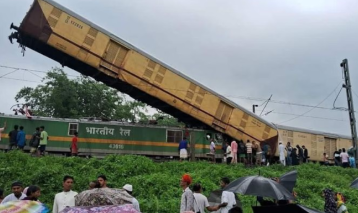What caused the tragic collision of the Kanchanjunga Express?
Early Monday morning, the Kanchanjunga Express, traveling from Agartala in Tripura to Sealdah in Kolkata, experienced a tragic accident when a goods train collided with it from behind near Rangapani station, close to New Jalpaiguri. The collision resulted in the deaths of nine people and injuries to 41 others. Initial reports indicate that the accident was caused by human error and a failure in the signaling system.
Read more: https://indiaobservers.com/train-accident-new-jalpaiguri-kanchanjunga-express-crash-details/
The Railway Board's preliminary report reveals that the goods train was operating under a defective automatic signaling system and was traveling above the speed limit when it struck the Kanchanjunga Express. According to railway protocol, when the automatic signaling system fails, a written authority known as ‘TA 912’ must be issued, allowing train drivers to pass all red signals. Both the Kanchanjunga Express and the goods train had received this authorization.
Under TA 912, drivers are required to stop for one minute at each defective signal and proceed at a maximum speed of 10 km/h, maintaining a 150-meter gap from the preceding train to ensure a safe stopping distance. However, the goods train driver violated these critical conditions. The Kanchanjunga Express had passed nine signals with TA 912 and had stopped after the ninth signal, awaiting further clearance.
The Railway Board confirmed that the goods train driver had been authorized to cross all red signals between Rangapani and Chattarhat railway stations due to the defective signaling system. The train, however, exceeded the permissible speed limit, leading to the collision with the stationary Kanchanjunga Express at 8:55 am.
The impact caused the derailment of the guard’s coach, two parcel coaches, and a general seating coach of the passenger train. Rescue operations began late in the afternoon, and several injured passengers were treated at the North Bengal Medical College and Hospital, with 41 remaining hospitalized, including nine in critical condition.
The Commissioner of Railway Safety (CRS) has initiated an investigation into the cause of the accident. Railway Minister Ashwini Vaishnaw visited the site to oversee relief operations and announced compensation for the victims’ families: ₹10 lakh for the families of the deceased, ₹2.5 lakh for the grievously injured, and ₹50,000 for those with minor injuries.
Prime Minister Narendra Modi expressed his condolences and prayed for the recovery of the injured. “The railway accident in West Bengal is saddening. Condolences to those who lost their loved ones. I pray that the injured recover at the earliest. Spoke to officials and took stock of the situation. Rescue operations are underway to assist the affected. The Railways Minister Shri Ashwini Vaishnaw Ji is on the way to the site of the mishap as well,” PM Modi posted on X.
West Bengal Chief Minister Mamata Banerjee criticized the Railway Ministry for neglecting passenger safety and failing to effectively implement the anti-collision system. She accused the railways of focusing more on fare hikes than on improving safety measures. “The railways have become totally parentless. Though the ministry is there, the old glory is missing. Only beautification is being done, but they do not care about passenger amenities. They are only keen on hiking fares,” she said. “You will only see them talk big. They also do not take care of the railway officers, technical, safety, and security personnel. I am with the railway employees and officers.”
Governor CV Ananda Bose urged that the focus should be on treating the victims rather than engaging in blame games.



Comments
Post a Comment